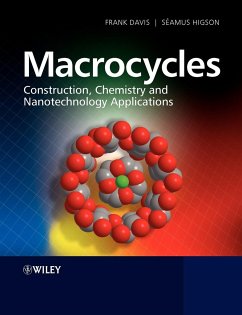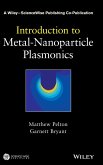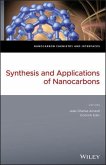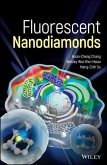- Broschiertes Buch
- Merkliste
- Auf die Merkliste
- Bewerten Bewerten
- Teilen
- Produkt teilen
- Produkterinnerung
- Produkterinnerung
Macrocyclic molecules contain rings made up of seven or more atoms. They are interesting because they provide building blocks for synthesizing precise two or three dimensional structures - an important goal in nanotechnology. For example, they can be used to develop nanosized reaction vessels, cages, switches and shuttles, and have potential as components in molecular computers. They also have applications as catalysts and sensors.
Macrocycles: Construction, Chemistry and Nanotechnology Applications is an essential introduction this important class of molecules and describes how to…mehr
Andere Kunden interessierten sich auch für
![Infochemistry Infochemistry]() Konrad SzacilowskiInfochemistry166,99 €
Konrad SzacilowskiInfochemistry166,99 €![Plasmonics Plasmonics]() Matthew PeltonPlasmonics134,99 €
Matthew PeltonPlasmonics134,99 €![Synthesis and Applications of Nanocarbons Synthesis and Applications of Nanocarbons]() Synthesis and Applications of Nanocarbons179,99 €
Synthesis and Applications of Nanocarbons179,99 €![One-Dimensional Nanostructures One-Dimensional Nanostructures]() Tianyou ZhaiOne-Dimensional Nanostructures190,99 €
Tianyou ZhaiOne-Dimensional Nanostructures190,99 €![Fluorescent Nanodiamonds Fluorescent Nanodiamonds]() Huan-Cheng ChangFluorescent Nanodiamonds158,99 €
Huan-Cheng ChangFluorescent Nanodiamonds158,99 €![Nanoparticulate Materials Nanoparticulate Materials]() K. LuNanoparticulate Materials187,99 €
K. LuNanoparticulate Materials187,99 €![Nanocarbons for Electroanalysis Nanocarbons for Electroanalysis]() Nanocarbons for Electroanalysis169,99 €
Nanocarbons for Electroanalysis169,99 €-
-
-
Macrocyclic molecules contain rings made up of seven or more atoms. They are interesting because they provide building blocks for synthesizing precise two or three dimensional structures - an important goal in nanotechnology. For example, they can be used to develop nanosized reaction vessels, cages, switches and shuttles, and have potential as components in molecular computers. They also have applications as catalysts and sensors.
Macrocycles: Construction, Chemistry and Nanotechnology Applications is an essential introduction this important class of molecules and describes how to synthesise them, their chemistry, how they can be used as nanotechnology building blocks, and their applications. A wide range of structures synthesised over the past few decades are covered, from the simpler cyclophanes and multi-ring aromatic structures to vases, bowls, cages and more complex multi-ring systems and 3D architectures such as "pumpkins", interlocking chains and knots. Topics covered include:
principles of macrocycle synthesis
simple ring compounds
multi-ring aromatic structures
porphyrins and phthalocanines
cyclophanes
crown ethers, cryptands and spherands
calixarenes, resorcinarenes, cavitands, carcerands, and heterocalixarenes
cyclodextrins
cucurbiturils
cyclotriveratylenes
rotaxanes
catenanes
complex 3D architectures, including trefoils and knots
Macrocycles: Construction, Chemistry and Nanotechnology Applications distills the essence of this important topic for undergraduate and postgraduate students, and for researchers in other fields interested in getting a general insight into this increasingly important class of molecules.
Macrocycles: Construction, Chemistry and Nanotechnology Applications is an essential introduction this important class of molecules and describes how to synthesise them, their chemistry, how they can be used as nanotechnology building blocks, and their applications. A wide range of structures synthesised over the past few decades are covered, from the simpler cyclophanes and multi-ring aromatic structures to vases, bowls, cages and more complex multi-ring systems and 3D architectures such as "pumpkins", interlocking chains and knots. Topics covered include:
principles of macrocycle synthesis
simple ring compounds
multi-ring aromatic structures
porphyrins and phthalocanines
cyclophanes
crown ethers, cryptands and spherands
calixarenes, resorcinarenes, cavitands, carcerands, and heterocalixarenes
cyclodextrins
cucurbiturils
cyclotriveratylenes
rotaxanes
catenanes
complex 3D architectures, including trefoils and knots
Macrocycles: Construction, Chemistry and Nanotechnology Applications distills the essence of this important topic for undergraduate and postgraduate students, and for researchers in other fields interested in getting a general insight into this increasingly important class of molecules.
Produktdetails
- Produktdetails
- Verlag: Wiley & Sons
- 1. Auflage
- Seitenzahl: 608
- Erscheinungstermin: 4. April 2011
- Englisch
- Abmessung: 246mm x 189mm x 33mm
- Gewicht: 1170g
- ISBN-13: 9780470714638
- ISBN-10: 0470714638
- Artikelnr.: 32734310
- Verlag: Wiley & Sons
- 1. Auflage
- Seitenzahl: 608
- Erscheinungstermin: 4. April 2011
- Englisch
- Abmessung: 246mm x 189mm x 33mm
- Gewicht: 1170g
- ISBN-13: 9780470714638
- ISBN-10: 0470714638
- Artikelnr.: 32734310
Dr Frank Davis Cranfield University, UK Dr Davis is a research fellow at Cranfield University, specialising in the biochemical and supramolecular aspects of electrochemistry. As well as pursuing academic research he has undertaken contract research for organisations such as Unilever Research (Port Sunlight), ITM Power Ltd (Sheffield), Timestrip (Hitchen) and DEFRA, and spent a 4-year research post within Gillette UK Professor Séamus Higson Cranfield University, UK Séamus Higson is Professor of Bio- and Electro-Analysis at Cranfield University which he joined in August 2002. His previous career spans academic departments of chemistry, medicine and materials science and this is reflected in his research. Professor Higson also serves within an advisory and / or consultative capacity for a number of public bodies and also acts as Technical Director for Microarray Ltd - a company formed upon science and patents originating from his group. His current research is primarily focussed towards practical implementation of electro analytical science and analytical biochemistry for biomedical, environmental and industrial process control applications.
Preface. 1. Introduction. 1.1. Simple ring compounds. 1.2. Three
dimensional aliphatic carbon structures. 1.3. Annulenes. 1.4. Multi-ring
aromatic structures. 1.5. Porpyrins and phthalocanines. 1.6. Conclusions.
References. 2. Cyclophanes. 2.1. Introduction to cyclophanes. 2.2.
Cyclophanes with one aromatic system and aliphatic chain. 2.3. Cyclophanes
with more than 1 aromatic ring. 2.4. Napthalenophanes and other aromatic
systems. 2.5. Cyclophanes containing heteroaromatic systems. 2.6.
Ferrocenophanes. References. 3. Crown ethers, cryptands and other
compounds. 3.1. Introduction. 3.2. Crown ethers. 3.3. Simple complexes with
crown ethers. 3.4. Azacrowns, cyclens and cyclams. 3.5. Crowns containing
other heteroatoms. 3.6. Lariat and bibracchial crown ethers. 3.7.
Cryptands. 3.8. Spherands. 3.9. Combined and multiple systems. 3.10.
Applications of crown ethers and related compounds. 3.11. Conclusions.
References. 4. Calixarenes. 4.1. Introduction to calixarenes. 4.2. History
of the calixarenes. 4.3. Structures of calixarenes. 4.4. Chemical
modification of calixarenes. 4.5. Complexes with calixarenes. 4.6. Bis- and
multicalixarenes. 4.7. Oxacalixarenes, azacalixarenes and thiacalixarenes.
4.8. Resorcinarenes - synthesis and structure. 4.9. Cavitands and
carcerands. 4.10. Uses of calixarenes and conclusions. References. 5.
Heterocalixarenes and calixnaphthalenes. 5.1. Introduction to
heterocalixarenes and calixnaphthalenes. 5.2. Calixnaphthalenes. 5.3.
Tropolone based macrocycles. 5.4. Calixfurans. 5.5. Calixpyrroles. 5.6.
Calixindoles, calixpyridines and calixthiophenes. 5.7. Conclusions.
References. 6. Cyclodextrins. 6.1. Introduction to cyclodextrins. 6.2.
Complex formation by cyclodextrins. 6.3. Cyclodextrins of other sizes. 6.4.
Modification reactions of cyclodextrins. 6.5. Selectivity of cyclodextrins.
6.6. Multiple cyclodextrin systems. 6.7. Polymeric cyclodextrins. 6.8.
Cyclodextrins combined with other macrocyclic systems. 6.9. Therapeutic
uses of cyclodextrins. 6.10. Other uses of cyclodextrins. 6.11.
Conclusions. References. 7. Cyclotriveratylenes and cryptophanes. 7.1.
Introduction to cyclotriveratrylenes and cryptophanes. 7.2. Synthesis of
cyclotriveratrylenes. 7.3. Modification of cyclotriveratrylenes. 7.4.
Synthesis of optically active cyclotriveratrylenes. 7.5. Modification of
the bridging groups. 7.6. Modification of the aromatic rings with
organometallic groups. 7.7. Selective binding applications of
cyclotriveratrylenes. 7.8. Analogues of CTV. 7.9. Cryptophanes - synthesis
and structure. 7.10. Cryptophanes - chemical modification. 7.11. Complexes
with cryptophanes. 7.12. Cryptophane/Xenon complexes. 7.13. Other uses of
cryptophanes. 7.14. Hemicryptophanes. 7.15. Conclusions. References. 8.
Cucurbiturils. 8.1. Introduction to cucurbiturils. 8.2. Complexation
behaviour of simple cucurbiturils. 8.3. Modification of cucurbiturils. 8.4.
Uses of cucurbiturils. 8.5. Hemicucurbiturils. 8.6. Conclusions.
References. 9. Rotaxanes and catenanes. 9.1. Introduction to rotaxanes and
catenanes. 9.2. Rotaxanes. 9.3. Rotaxanes as molecular machines. 9.4. Thin
films of rotaxanes. 9.5. Polyrotaxanes. 9.6. Catenanes. 9.7. Switchable
catenanes. 9.8. Catenanes on surfaces. 9.9. Polycatenanes and catenated
polymers. 9.10. Natural catenanes. 9.11. Conclusions. References. 10. Other
supermolecular systems, molecular motors, machines and nanotechnological
applications. 10.1. Introduction. 10.2. Other molecular systems. 10.3.
Molecular devices, motors and machines. 10.4. Conclusions. References.
dimensional aliphatic carbon structures. 1.3. Annulenes. 1.4. Multi-ring
aromatic structures. 1.5. Porpyrins and phthalocanines. 1.6. Conclusions.
References. 2. Cyclophanes. 2.1. Introduction to cyclophanes. 2.2.
Cyclophanes with one aromatic system and aliphatic chain. 2.3. Cyclophanes
with more than 1 aromatic ring. 2.4. Napthalenophanes and other aromatic
systems. 2.5. Cyclophanes containing heteroaromatic systems. 2.6.
Ferrocenophanes. References. 3. Crown ethers, cryptands and other
compounds. 3.1. Introduction. 3.2. Crown ethers. 3.3. Simple complexes with
crown ethers. 3.4. Azacrowns, cyclens and cyclams. 3.5. Crowns containing
other heteroatoms. 3.6. Lariat and bibracchial crown ethers. 3.7.
Cryptands. 3.8. Spherands. 3.9. Combined and multiple systems. 3.10.
Applications of crown ethers and related compounds. 3.11. Conclusions.
References. 4. Calixarenes. 4.1. Introduction to calixarenes. 4.2. History
of the calixarenes. 4.3. Structures of calixarenes. 4.4. Chemical
modification of calixarenes. 4.5. Complexes with calixarenes. 4.6. Bis- and
multicalixarenes. 4.7. Oxacalixarenes, azacalixarenes and thiacalixarenes.
4.8. Resorcinarenes - synthesis and structure. 4.9. Cavitands and
carcerands. 4.10. Uses of calixarenes and conclusions. References. 5.
Heterocalixarenes and calixnaphthalenes. 5.1. Introduction to
heterocalixarenes and calixnaphthalenes. 5.2. Calixnaphthalenes. 5.3.
Tropolone based macrocycles. 5.4. Calixfurans. 5.5. Calixpyrroles. 5.6.
Calixindoles, calixpyridines and calixthiophenes. 5.7. Conclusions.
References. 6. Cyclodextrins. 6.1. Introduction to cyclodextrins. 6.2.
Complex formation by cyclodextrins. 6.3. Cyclodextrins of other sizes. 6.4.
Modification reactions of cyclodextrins. 6.5. Selectivity of cyclodextrins.
6.6. Multiple cyclodextrin systems. 6.7. Polymeric cyclodextrins. 6.8.
Cyclodextrins combined with other macrocyclic systems. 6.9. Therapeutic
uses of cyclodextrins. 6.10. Other uses of cyclodextrins. 6.11.
Conclusions. References. 7. Cyclotriveratylenes and cryptophanes. 7.1.
Introduction to cyclotriveratrylenes and cryptophanes. 7.2. Synthesis of
cyclotriveratrylenes. 7.3. Modification of cyclotriveratrylenes. 7.4.
Synthesis of optically active cyclotriveratrylenes. 7.5. Modification of
the bridging groups. 7.6. Modification of the aromatic rings with
organometallic groups. 7.7. Selective binding applications of
cyclotriveratrylenes. 7.8. Analogues of CTV. 7.9. Cryptophanes - synthesis
and structure. 7.10. Cryptophanes - chemical modification. 7.11. Complexes
with cryptophanes. 7.12. Cryptophane/Xenon complexes. 7.13. Other uses of
cryptophanes. 7.14. Hemicryptophanes. 7.15. Conclusions. References. 8.
Cucurbiturils. 8.1. Introduction to cucurbiturils. 8.2. Complexation
behaviour of simple cucurbiturils. 8.3. Modification of cucurbiturils. 8.4.
Uses of cucurbiturils. 8.5. Hemicucurbiturils. 8.6. Conclusions.
References. 9. Rotaxanes and catenanes. 9.1. Introduction to rotaxanes and
catenanes. 9.2. Rotaxanes. 9.3. Rotaxanes as molecular machines. 9.4. Thin
films of rotaxanes. 9.5. Polyrotaxanes. 9.6. Catenanes. 9.7. Switchable
catenanes. 9.8. Catenanes on surfaces. 9.9. Polycatenanes and catenated
polymers. 9.10. Natural catenanes. 9.11. Conclusions. References. 10. Other
supermolecular systems, molecular motors, machines and nanotechnological
applications. 10.1. Introduction. 10.2. Other molecular systems. 10.3.
Molecular devices, motors and machines. 10.4. Conclusions. References.
Preface.
1 Introduction.
1.1 Simple Ring Compounds.
1.2 Three-Dimensional Aliphatic Carbon Structures.
1.3 Annulenes.
1.4 Multi-Ring Aromatic Structures.
1.5 Porpyrins and Phthalocanines.
1.6 Conclusions.
References.
2 Cyclophanes.
2.1 Introduction.
2.2 Cyclophanes with One Aromatic System and AliphaticChain.
2.3 Cyclophanes with More than One Aromatic Ring.
2.4 Napthalenophanes and Other Aromatic Systems.
2.5 Cyclophanes Containing Heteroaromatic Systems.
2.6 Ferrocenophanes.
2.7 Conclusions.
Bibliography.
References.
3 Crown Ethers, Cryptands and Other Compounds.
3.1 Introduction.
3.2 Crown Ethers.
3.3 Simple Complexes with Crown Ethers.
3.4 Azacrowns, Cyclens and Cyclams.
3.5 Crowns Containing Other Heteroatoms.
3.6 Lariat and Bibracchial Crown Ethers.
3.7 Cryptands.
3.8 Spherands.
3.9 Combined and Multiple Systems.
3.10 Applications of Crown Ethers and Related Compounds.
3.11 Conclusions.
Bibliography.
References.
4 Calixarenes.
4.1 Introduction.
4.2 History.
4.3 Structures of Calixarenes.
4.4 Chemical Modification of Calixarenes.
4.5 Complexes with Calixarenes.
4.6 Bis and Multicalixarenes.
4.7 Oxacalixarenes, Azacalixarenes and Thiacalixarenes.
4.8 Resorcinarenes: Synthesis and Structure.
4.9 Cavitands and Carcerands.
4.10 Conclusions.
Bibliography.
References.
5 Heterocalixarenes and Calixnaphthalenes.
5.1 Introduction.
5.2 Calixnaphthalenes.
5.3 Tropolone-Based Macrocycles.
5.4 Calixfurans.
5.5 Calixpyrroles.
5.6 Calixindoles, Calixpyridines and Calixthiophenes.
5.7 Conclusions.
Bibliography.
References.
6 Cyclodextrins.
6.1 Introduction.
6.2 Complex Formation by Cyclodextrins.
6.3 Cyclodextrins of Other Sizes.
6.4 Modification Reactions of Cyclodextrins.
6.5 Selectivity of Cyclodextrins.
6.6 Multiple Cyclodextrin Systems.
6.7 Polymeric Cyclodextrins.
6.8 Cyclodextrins Combined with Other Macrocyclic Systems.
6.9 Therapeutic Uses of Cyclodextrins.
6.10 Other Uses of Cyclodextrins.
6.11 Conclusions.
Bibliography.
References.
7 Cyclotriveratylenes and Cryptophanes.
7.1 Introduction.
7.2 Synthesis of Cyclotriveratrylenes.
7.3 Modification of Cyclotriveratrylenes.
7.4 Synthesis of Optically Active Cyclotriveratrylenes.
7.5 Modification of the Bridging Groups.
7.6 Modification of the Aromatic Rings with OrganometallicGroups.
7.7 Selective Binding Applications of Cyclotriveratrylenes.
7.8 Analogues of CTV.
7.9 Synthesis and Structure of Cryptophanes.
7.10 Modification of Cryptophanes.
7.11 Complexes with Cryptophanes.
7.12 Cryptophane-Xenon Complexes.
7.13 Other Uses of Cryptophanes.
7.14 Hemicryptophanes.
7.15 Conclusions.
Bibliography.
References.
8 Cucurbiturils.
8.1 Introduction.
8.2 Complexation Behaviour of Simple Cucurbiturils.
8.3 Modification of Cucurbiturils.
8.4 Uses of Cucurbiturils.
8.5 Hemicucurbiturils.
8.6 Conclusions.
Bibliography.
References.
9 Rotaxanes and Catenanes.
9.1 Introduction.
9.2 Rotaxanes.
9.3 Catenanes.
9.4 Conclusions.
Bibliography.
References.
10 Other Supramolecular Systems, Molecular Motors, Machinesand Nanotechnological Applications.
10.1 Introduction.
10.2 Other Molecular Systems.
10.3 Molecular Devices, Motors and Machines.
10.4 Conclusions.
Bibliography.
References.
Index.
1 Introduction.
1.1 Simple Ring Compounds.
1.2 Three-Dimensional Aliphatic Carbon Structures.
1.3 Annulenes.
1.4 Multi-Ring Aromatic Structures.
1.5 Porpyrins and Phthalocanines.
1.6 Conclusions.
References.
2 Cyclophanes.
2.1 Introduction.
2.2 Cyclophanes with One Aromatic System and AliphaticChain.
2.3 Cyclophanes with More than One Aromatic Ring.
2.4 Napthalenophanes and Other Aromatic Systems.
2.5 Cyclophanes Containing Heteroaromatic Systems.
2.6 Ferrocenophanes.
2.7 Conclusions.
Bibliography.
References.
3 Crown Ethers, Cryptands and Other Compounds.
3.1 Introduction.
3.2 Crown Ethers.
3.3 Simple Complexes with Crown Ethers.
3.4 Azacrowns, Cyclens and Cyclams.
3.5 Crowns Containing Other Heteroatoms.
3.6 Lariat and Bibracchial Crown Ethers.
3.7 Cryptands.
3.8 Spherands.
3.9 Combined and Multiple Systems.
3.10 Applications of Crown Ethers and Related Compounds.
3.11 Conclusions.
Bibliography.
References.
4 Calixarenes.
4.1 Introduction.
4.2 History.
4.3 Structures of Calixarenes.
4.4 Chemical Modification of Calixarenes.
4.5 Complexes with Calixarenes.
4.6 Bis and Multicalixarenes.
4.7 Oxacalixarenes, Azacalixarenes and Thiacalixarenes.
4.8 Resorcinarenes: Synthesis and Structure.
4.9 Cavitands and Carcerands.
4.10 Conclusions.
Bibliography.
References.
5 Heterocalixarenes and Calixnaphthalenes.
5.1 Introduction.
5.2 Calixnaphthalenes.
5.3 Tropolone-Based Macrocycles.
5.4 Calixfurans.
5.5 Calixpyrroles.
5.6 Calixindoles, Calixpyridines and Calixthiophenes.
5.7 Conclusions.
Bibliography.
References.
6 Cyclodextrins.
6.1 Introduction.
6.2 Complex Formation by Cyclodextrins.
6.3 Cyclodextrins of Other Sizes.
6.4 Modification Reactions of Cyclodextrins.
6.5 Selectivity of Cyclodextrins.
6.6 Multiple Cyclodextrin Systems.
6.7 Polymeric Cyclodextrins.
6.8 Cyclodextrins Combined with Other Macrocyclic Systems.
6.9 Therapeutic Uses of Cyclodextrins.
6.10 Other Uses of Cyclodextrins.
6.11 Conclusions.
Bibliography.
References.
7 Cyclotriveratylenes and Cryptophanes.
7.1 Introduction.
7.2 Synthesis of Cyclotriveratrylenes.
7.3 Modification of Cyclotriveratrylenes.
7.4 Synthesis of Optically Active Cyclotriveratrylenes.
7.5 Modification of the Bridging Groups.
7.6 Modification of the Aromatic Rings with OrganometallicGroups.
7.7 Selective Binding Applications of Cyclotriveratrylenes.
7.8 Analogues of CTV.
7.9 Synthesis and Structure of Cryptophanes.
7.10 Modification of Cryptophanes.
7.11 Complexes with Cryptophanes.
7.12 Cryptophane-Xenon Complexes.
7.13 Other Uses of Cryptophanes.
7.14 Hemicryptophanes.
7.15 Conclusions.
Bibliography.
References.
8 Cucurbiturils.
8.1 Introduction.
8.2 Complexation Behaviour of Simple Cucurbiturils.
8.3 Modification of Cucurbiturils.
8.4 Uses of Cucurbiturils.
8.5 Hemicucurbiturils.
8.6 Conclusions.
Bibliography.
References.
9 Rotaxanes and Catenanes.
9.1 Introduction.
9.2 Rotaxanes.
9.3 Catenanes.
9.4 Conclusions.
Bibliography.
References.
10 Other Supramolecular Systems, Molecular Motors, Machinesand Nanotechnological Applications.
10.1 Introduction.
10.2 Other Molecular Systems.
10.3 Molecular Devices, Motors and Machines.
10.4 Conclusions.
Bibliography.
References.
Index.
Preface. 1. Introduction. 1.1. Simple ring compounds. 1.2. Three
dimensional aliphatic carbon structures. 1.3. Annulenes. 1.4. Multi-ring
aromatic structures. 1.5. Porpyrins and phthalocanines. 1.6. Conclusions.
References. 2. Cyclophanes. 2.1. Introduction to cyclophanes. 2.2.
Cyclophanes with one aromatic system and aliphatic chain. 2.3. Cyclophanes
with more than 1 aromatic ring. 2.4. Napthalenophanes and other aromatic
systems. 2.5. Cyclophanes containing heteroaromatic systems. 2.6.
Ferrocenophanes. References. 3. Crown ethers, cryptands and other
compounds. 3.1. Introduction. 3.2. Crown ethers. 3.3. Simple complexes with
crown ethers. 3.4. Azacrowns, cyclens and cyclams. 3.5. Crowns containing
other heteroatoms. 3.6. Lariat and bibracchial crown ethers. 3.7.
Cryptands. 3.8. Spherands. 3.9. Combined and multiple systems. 3.10.
Applications of crown ethers and related compounds. 3.11. Conclusions.
References. 4. Calixarenes. 4.1. Introduction to calixarenes. 4.2. History
of the calixarenes. 4.3. Structures of calixarenes. 4.4. Chemical
modification of calixarenes. 4.5. Complexes with calixarenes. 4.6. Bis- and
multicalixarenes. 4.7. Oxacalixarenes, azacalixarenes and thiacalixarenes.
4.8. Resorcinarenes - synthesis and structure. 4.9. Cavitands and
carcerands. 4.10. Uses of calixarenes and conclusions. References. 5.
Heterocalixarenes and calixnaphthalenes. 5.1. Introduction to
heterocalixarenes and calixnaphthalenes. 5.2. Calixnaphthalenes. 5.3.
Tropolone based macrocycles. 5.4. Calixfurans. 5.5. Calixpyrroles. 5.6.
Calixindoles, calixpyridines and calixthiophenes. 5.7. Conclusions.
References. 6. Cyclodextrins. 6.1. Introduction to cyclodextrins. 6.2.
Complex formation by cyclodextrins. 6.3. Cyclodextrins of other sizes. 6.4.
Modification reactions of cyclodextrins. 6.5. Selectivity of cyclodextrins.
6.6. Multiple cyclodextrin systems. 6.7. Polymeric cyclodextrins. 6.8.
Cyclodextrins combined with other macrocyclic systems. 6.9. Therapeutic
uses of cyclodextrins. 6.10. Other uses of cyclodextrins. 6.11.
Conclusions. References. 7. Cyclotriveratylenes and cryptophanes. 7.1.
Introduction to cyclotriveratrylenes and cryptophanes. 7.2. Synthesis of
cyclotriveratrylenes. 7.3. Modification of cyclotriveratrylenes. 7.4.
Synthesis of optically active cyclotriveratrylenes. 7.5. Modification of
the bridging groups. 7.6. Modification of the aromatic rings with
organometallic groups. 7.7. Selective binding applications of
cyclotriveratrylenes. 7.8. Analogues of CTV. 7.9. Cryptophanes - synthesis
and structure. 7.10. Cryptophanes - chemical modification. 7.11. Complexes
with cryptophanes. 7.12. Cryptophane/Xenon complexes. 7.13. Other uses of
cryptophanes. 7.14. Hemicryptophanes. 7.15. Conclusions. References. 8.
Cucurbiturils. 8.1. Introduction to cucurbiturils. 8.2. Complexation
behaviour of simple cucurbiturils. 8.3. Modification of cucurbiturils. 8.4.
Uses of cucurbiturils. 8.5. Hemicucurbiturils. 8.6. Conclusions.
References. 9. Rotaxanes and catenanes. 9.1. Introduction to rotaxanes and
catenanes. 9.2. Rotaxanes. 9.3. Rotaxanes as molecular machines. 9.4. Thin
films of rotaxanes. 9.5. Polyrotaxanes. 9.6. Catenanes. 9.7. Switchable
catenanes. 9.8. Catenanes on surfaces. 9.9. Polycatenanes and catenated
polymers. 9.10. Natural catenanes. 9.11. Conclusions. References. 10. Other
supermolecular systems, molecular motors, machines and nanotechnological
applications. 10.1. Introduction. 10.2. Other molecular systems. 10.3.
Molecular devices, motors and machines. 10.4. Conclusions. References.
dimensional aliphatic carbon structures. 1.3. Annulenes. 1.4. Multi-ring
aromatic structures. 1.5. Porpyrins and phthalocanines. 1.6. Conclusions.
References. 2. Cyclophanes. 2.1. Introduction to cyclophanes. 2.2.
Cyclophanes with one aromatic system and aliphatic chain. 2.3. Cyclophanes
with more than 1 aromatic ring. 2.4. Napthalenophanes and other aromatic
systems. 2.5. Cyclophanes containing heteroaromatic systems. 2.6.
Ferrocenophanes. References. 3. Crown ethers, cryptands and other
compounds. 3.1. Introduction. 3.2. Crown ethers. 3.3. Simple complexes with
crown ethers. 3.4. Azacrowns, cyclens and cyclams. 3.5. Crowns containing
other heteroatoms. 3.6. Lariat and bibracchial crown ethers. 3.7.
Cryptands. 3.8. Spherands. 3.9. Combined and multiple systems. 3.10.
Applications of crown ethers and related compounds. 3.11. Conclusions.
References. 4. Calixarenes. 4.1. Introduction to calixarenes. 4.2. History
of the calixarenes. 4.3. Structures of calixarenes. 4.4. Chemical
modification of calixarenes. 4.5. Complexes with calixarenes. 4.6. Bis- and
multicalixarenes. 4.7. Oxacalixarenes, azacalixarenes and thiacalixarenes.
4.8. Resorcinarenes - synthesis and structure. 4.9. Cavitands and
carcerands. 4.10. Uses of calixarenes and conclusions. References. 5.
Heterocalixarenes and calixnaphthalenes. 5.1. Introduction to
heterocalixarenes and calixnaphthalenes. 5.2. Calixnaphthalenes. 5.3.
Tropolone based macrocycles. 5.4. Calixfurans. 5.5. Calixpyrroles. 5.6.
Calixindoles, calixpyridines and calixthiophenes. 5.7. Conclusions.
References. 6. Cyclodextrins. 6.1. Introduction to cyclodextrins. 6.2.
Complex formation by cyclodextrins. 6.3. Cyclodextrins of other sizes. 6.4.
Modification reactions of cyclodextrins. 6.5. Selectivity of cyclodextrins.
6.6. Multiple cyclodextrin systems. 6.7. Polymeric cyclodextrins. 6.8.
Cyclodextrins combined with other macrocyclic systems. 6.9. Therapeutic
uses of cyclodextrins. 6.10. Other uses of cyclodextrins. 6.11.
Conclusions. References. 7. Cyclotriveratylenes and cryptophanes. 7.1.
Introduction to cyclotriveratrylenes and cryptophanes. 7.2. Synthesis of
cyclotriveratrylenes. 7.3. Modification of cyclotriveratrylenes. 7.4.
Synthesis of optically active cyclotriveratrylenes. 7.5. Modification of
the bridging groups. 7.6. Modification of the aromatic rings with
organometallic groups. 7.7. Selective binding applications of
cyclotriveratrylenes. 7.8. Analogues of CTV. 7.9. Cryptophanes - synthesis
and structure. 7.10. Cryptophanes - chemical modification. 7.11. Complexes
with cryptophanes. 7.12. Cryptophane/Xenon complexes. 7.13. Other uses of
cryptophanes. 7.14. Hemicryptophanes. 7.15. Conclusions. References. 8.
Cucurbiturils. 8.1. Introduction to cucurbiturils. 8.2. Complexation
behaviour of simple cucurbiturils. 8.3. Modification of cucurbiturils. 8.4.
Uses of cucurbiturils. 8.5. Hemicucurbiturils. 8.6. Conclusions.
References. 9. Rotaxanes and catenanes. 9.1. Introduction to rotaxanes and
catenanes. 9.2. Rotaxanes. 9.3. Rotaxanes as molecular machines. 9.4. Thin
films of rotaxanes. 9.5. Polyrotaxanes. 9.6. Catenanes. 9.7. Switchable
catenanes. 9.8. Catenanes on surfaces. 9.9. Polycatenanes and catenated
polymers. 9.10. Natural catenanes. 9.11. Conclusions. References. 10. Other
supermolecular systems, molecular motors, machines and nanotechnological
applications. 10.1. Introduction. 10.2. Other molecular systems. 10.3.
Molecular devices, motors and machines. 10.4. Conclusions. References.
Preface.
1 Introduction.
1.1 Simple Ring Compounds.
1.2 Three-Dimensional Aliphatic Carbon Structures.
1.3 Annulenes.
1.4 Multi-Ring Aromatic Structures.
1.5 Porpyrins and Phthalocanines.
1.6 Conclusions.
References.
2 Cyclophanes.
2.1 Introduction.
2.2 Cyclophanes with One Aromatic System and AliphaticChain.
2.3 Cyclophanes with More than One Aromatic Ring.
2.4 Napthalenophanes and Other Aromatic Systems.
2.5 Cyclophanes Containing Heteroaromatic Systems.
2.6 Ferrocenophanes.
2.7 Conclusions.
Bibliography.
References.
3 Crown Ethers, Cryptands and Other Compounds.
3.1 Introduction.
3.2 Crown Ethers.
3.3 Simple Complexes with Crown Ethers.
3.4 Azacrowns, Cyclens and Cyclams.
3.5 Crowns Containing Other Heteroatoms.
3.6 Lariat and Bibracchial Crown Ethers.
3.7 Cryptands.
3.8 Spherands.
3.9 Combined and Multiple Systems.
3.10 Applications of Crown Ethers and Related Compounds.
3.11 Conclusions.
Bibliography.
References.
4 Calixarenes.
4.1 Introduction.
4.2 History.
4.3 Structures of Calixarenes.
4.4 Chemical Modification of Calixarenes.
4.5 Complexes with Calixarenes.
4.6 Bis and Multicalixarenes.
4.7 Oxacalixarenes, Azacalixarenes and Thiacalixarenes.
4.8 Resorcinarenes: Synthesis and Structure.
4.9 Cavitands and Carcerands.
4.10 Conclusions.
Bibliography.
References.
5 Heterocalixarenes and Calixnaphthalenes.
5.1 Introduction.
5.2 Calixnaphthalenes.
5.3 Tropolone-Based Macrocycles.
5.4 Calixfurans.
5.5 Calixpyrroles.
5.6 Calixindoles, Calixpyridines and Calixthiophenes.
5.7 Conclusions.
Bibliography.
References.
6 Cyclodextrins.
6.1 Introduction.
6.2 Complex Formation by Cyclodextrins.
6.3 Cyclodextrins of Other Sizes.
6.4 Modification Reactions of Cyclodextrins.
6.5 Selectivity of Cyclodextrins.
6.6 Multiple Cyclodextrin Systems.
6.7 Polymeric Cyclodextrins.
6.8 Cyclodextrins Combined with Other Macrocyclic Systems.
6.9 Therapeutic Uses of Cyclodextrins.
6.10 Other Uses of Cyclodextrins.
6.11 Conclusions.
Bibliography.
References.
7 Cyclotriveratylenes and Cryptophanes.
7.1 Introduction.
7.2 Synthesis of Cyclotriveratrylenes.
7.3 Modification of Cyclotriveratrylenes.
7.4 Synthesis of Optically Active Cyclotriveratrylenes.
7.5 Modification of the Bridging Groups.
7.6 Modification of the Aromatic Rings with OrganometallicGroups.
7.7 Selective Binding Applications of Cyclotriveratrylenes.
7.8 Analogues of CTV.
7.9 Synthesis and Structure of Cryptophanes.
7.10 Modification of Cryptophanes.
7.11 Complexes with Cryptophanes.
7.12 Cryptophane-Xenon Complexes.
7.13 Other Uses of Cryptophanes.
7.14 Hemicryptophanes.
7.15 Conclusions.
Bibliography.
References.
8 Cucurbiturils.
8.1 Introduction.
8.2 Complexation Behaviour of Simple Cucurbiturils.
8.3 Modification of Cucurbiturils.
8.4 Uses of Cucurbiturils.
8.5 Hemicucurbiturils.
8.6 Conclusions.
Bibliography.
References.
9 Rotaxanes and Catenanes.
9.1 Introduction.
9.2 Rotaxanes.
9.3 Catenanes.
9.4 Conclusions.
Bibliography.
References.
10 Other Supramolecular Systems, Molecular Motors, Machinesand Nanotechnological Applications.
10.1 Introduction.
10.2 Other Molecular Systems.
10.3 Molecular Devices, Motors and Machines.
10.4 Conclusions.
Bibliography.
References.
Index.
1 Introduction.
1.1 Simple Ring Compounds.
1.2 Three-Dimensional Aliphatic Carbon Structures.
1.3 Annulenes.
1.4 Multi-Ring Aromatic Structures.
1.5 Porpyrins and Phthalocanines.
1.6 Conclusions.
References.
2 Cyclophanes.
2.1 Introduction.
2.2 Cyclophanes with One Aromatic System and AliphaticChain.
2.3 Cyclophanes with More than One Aromatic Ring.
2.4 Napthalenophanes and Other Aromatic Systems.
2.5 Cyclophanes Containing Heteroaromatic Systems.
2.6 Ferrocenophanes.
2.7 Conclusions.
Bibliography.
References.
3 Crown Ethers, Cryptands and Other Compounds.
3.1 Introduction.
3.2 Crown Ethers.
3.3 Simple Complexes with Crown Ethers.
3.4 Azacrowns, Cyclens and Cyclams.
3.5 Crowns Containing Other Heteroatoms.
3.6 Lariat and Bibracchial Crown Ethers.
3.7 Cryptands.
3.8 Spherands.
3.9 Combined and Multiple Systems.
3.10 Applications of Crown Ethers and Related Compounds.
3.11 Conclusions.
Bibliography.
References.
4 Calixarenes.
4.1 Introduction.
4.2 History.
4.3 Structures of Calixarenes.
4.4 Chemical Modification of Calixarenes.
4.5 Complexes with Calixarenes.
4.6 Bis and Multicalixarenes.
4.7 Oxacalixarenes, Azacalixarenes and Thiacalixarenes.
4.8 Resorcinarenes: Synthesis and Structure.
4.9 Cavitands and Carcerands.
4.10 Conclusions.
Bibliography.
References.
5 Heterocalixarenes and Calixnaphthalenes.
5.1 Introduction.
5.2 Calixnaphthalenes.
5.3 Tropolone-Based Macrocycles.
5.4 Calixfurans.
5.5 Calixpyrroles.
5.6 Calixindoles, Calixpyridines and Calixthiophenes.
5.7 Conclusions.
Bibliography.
References.
6 Cyclodextrins.
6.1 Introduction.
6.2 Complex Formation by Cyclodextrins.
6.3 Cyclodextrins of Other Sizes.
6.4 Modification Reactions of Cyclodextrins.
6.5 Selectivity of Cyclodextrins.
6.6 Multiple Cyclodextrin Systems.
6.7 Polymeric Cyclodextrins.
6.8 Cyclodextrins Combined with Other Macrocyclic Systems.
6.9 Therapeutic Uses of Cyclodextrins.
6.10 Other Uses of Cyclodextrins.
6.11 Conclusions.
Bibliography.
References.
7 Cyclotriveratylenes and Cryptophanes.
7.1 Introduction.
7.2 Synthesis of Cyclotriveratrylenes.
7.3 Modification of Cyclotriveratrylenes.
7.4 Synthesis of Optically Active Cyclotriveratrylenes.
7.5 Modification of the Bridging Groups.
7.6 Modification of the Aromatic Rings with OrganometallicGroups.
7.7 Selective Binding Applications of Cyclotriveratrylenes.
7.8 Analogues of CTV.
7.9 Synthesis and Structure of Cryptophanes.
7.10 Modification of Cryptophanes.
7.11 Complexes with Cryptophanes.
7.12 Cryptophane-Xenon Complexes.
7.13 Other Uses of Cryptophanes.
7.14 Hemicryptophanes.
7.15 Conclusions.
Bibliography.
References.
8 Cucurbiturils.
8.1 Introduction.
8.2 Complexation Behaviour of Simple Cucurbiturils.
8.3 Modification of Cucurbiturils.
8.4 Uses of Cucurbiturils.
8.5 Hemicucurbiturils.
8.6 Conclusions.
Bibliography.
References.
9 Rotaxanes and Catenanes.
9.1 Introduction.
9.2 Rotaxanes.
9.3 Catenanes.
9.4 Conclusions.
Bibliography.
References.
10 Other Supramolecular Systems, Molecular Motors, Machinesand Nanotechnological Applications.
10.1 Introduction.
10.2 Other Molecular Systems.
10.3 Molecular Devices, Motors and Machines.
10.4 Conclusions.
Bibliography.
References.
Index.
"Macrocycles : Construction, Chemistry and NanotechnologyApplications distils the essence of this important topic forundergraduate and postgraduate students, and for researchers inother fields who are interested in getting a general insight intothis increasingly important class of molecules." (Chimie Nouvelle, 1 March 2013)








